SOLE SEARCHING: 8 Tips to Finding Your Perfect Pair of Athletic Shoes (Tips #7 & #8)


Tip #7 Take ‘em For a Spin/ Tip #8 Stylin and Profilin
If the pair of shoes that you have been scoping has made it this far on the tips list, then that’s a pretty good sign. But you don’t buy a car without going for a test spin or sign on the dotted line before purchasing a home, and neither should be the case for shoes. Never hesitate to walk around the shoe store or even jog in place to ensure that you have truly become one with your goody two shoes. There should be absolutely NO break-in period when buying shoes (sorry Mom!).
Shoes should be treated as a wise investment- much like cars and homes. We only get one pair of feet for a lifetime, so we have to treat with the utmost care!
It is worth noting that no matter how taylor-made a pair of shoes may seem for your feet- in terms matching foot type, fit, and comfort- the bottom line is that unless your shoes look any good, you’re not likely to wear them. In the midst of finding comfort, that element of eye-candy certainly plays a part. The style should not be “the” determining factor, however. After all, it’s what’s on the inside that matters most (Awww!).
Won’t you share your thoughts on the steps mentioned?
Don’t forget to LIKE US on facebook!!
Putting your best FEET forward,
SH
SOLE SEARCHING: 8 Tips to Finding Your Perfect Pair of Athletic Shoes (Tip #6)

www.thebrainygal.com
Tip #6 Moments of Truth
So here it is…It has come down to this…. It’s late in the afternoon, you’re shopping for a spiffy new pair, and you luck out to find the perfect sales clerk that has been able to meet your every need. They’ve analyzed your feet and they have your gait pattern down to a science. All good, right!?!.....well not quite! There are still three simple tests you need to perform to complete your conquest:
· Heel counter Test- A strong heel counter makes for a stable heel and thus a stable foot altogether. Simply grasp the mid-portion of the heel from the sides using your thumb and index finger and squeeze firmly. If the heel counter hardly gives, you have a well fortified heel counter- crucial for overpronators.
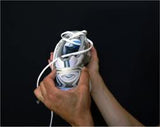
www.safestepblog.net
· Flexion Test- A well made sole should hold firm and ONLY bend at the widest part of your shoe- the ball of your foot. Take the shoe, holding the opposite ends in both hands. Fold the shoe upward attempting to bring you hands together. The shoe should only fold at the ball of the foot (aka the breakpoint). Your foot only bends at the ball of the foot and so should your shoes.

www.safestepblog.net
· Torsion Test- medial and lateral flexibility of the sole is fine, but too much of it can spell danger for a pair of shoes. To find out, hold the shoe as you would for the flexion test, but instead twist the front and back of the shoe in opposite directions. Again, some flexibility is expected, but you SHOULD NOT be able to twist the shoe onto itself.
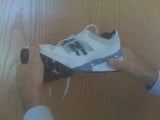
www.drblakeshealingsole.com
Won’t you share your thoughts on the steps mentioned?
Don’t forget to LIKE US on facebook!!
Putting your best FEET forward,
SH
SOLE SEARCHING: 8 Tips to Finding Your Perfect Pair of Athletic Shoes (Tip #5)

www.mymarilee.com
Tip #5 The Long and the Short of it…
All feet are NOT created equal...even our own two feet we use everyday. It is NOT uncommon to find one foot to be longer than the other. Actually, it is quite normal. Studies show that 60% of individuals have different sized feet. That’s why it is imperative to measure your feet each time you set out to purchase a pair of shoes.
But one thing to ALWAYS remember is to have your feet measured while standing up. Our feet expand when they bear weight, taking into account the width of our foot within shoes. If you are among the majority, you should aim to buy shoes that fit the larger foot (if a half to a full size difference). If greater than a full shoe size difference, you may need to where mismatch sizes to accommodate the increased difference (FYI a shoe size is roughly 1/3 of an inch).
Also, make sure that there is a thumb-width distance from the end of your longest toe (USUALLY the big toe, but the 2nd toe for some) to the edge of the toe box within the shoe. Wiggling of the toes should be able to be done with ease.
Don’t forget to LIKE US on facebook!!
Putting your best FEET forward,
SH
SOLE SEARCHING: 8 Tips to Finding Your Perfect Pair of Athletic Shoes (Tip #4)

www.liftforlife.com
Tip #4 Rubber Meets the Road
When on that mission to find the right shoes, you should definitely come armed with a pair of well-worn sneaks. Much like the tires on a car, the soles on our shoes become worn from prolonged usage and pounding of the pavement. In fact, the pattern in which the rubber on the bottom of our shoes becomes worn can indicate the way in which we walk (better known in the podiatry world as our gait pattern). If you have the good fortune of finding an experienced, knowledgeable sales clerk, they will likely be able to analyze your wear pattern to help find the perfect shoes for you!
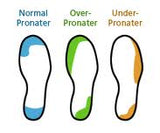

However if you are not so fortunate, you can examine your own pair of shoes to identify your gait pattern. If you are considered an underpronator, you have a tendency to supinate-during heel strike, midstance, and propulsion- causing you soles to be excessively worn at the lateral forefoot and heel. Overpronators heel strike on the lateral heel when walking, but OVERpronate with midstance and propulsion (hence the name) causing more wear on the medial forefoot. Normal pronators supinate with heel strike, but gradually progress to pronation with midstance and propulsion causing a uniform wear of the sole of the heel and forefoot.
Other items to keep in your arsenal of shoe shopping are a pair of socks. That’s right!...but not just any pair of socks….they should be socks that you will likely wear when donning your shoes of choice. The idea is to treat those pair of shoes as if you already own them, making sure that they fit comfortably for normal day-to-day use.
AGAIN, think hand-in-glove relationship!
Don’t forget to LIKE US on facebook!!
Putting your best FEET forward,
SH
SOLE SEARCHING: 8 Tips to Finding Your Perfect Pair of Athletic Shoes (Tip #3)
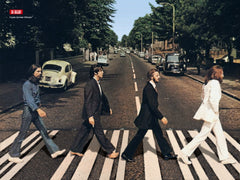
Photo courtesy of The Beatles 1969 Album Cover: Abbey Road
Tip #3 Walk This Way
High, low, or smack-dab in the middle (neutral)… chances are your feet arches fall into one of these three categories. While a small chunk of the population (~25%) have neutral arches, much of the population fall either in the high or low categories (~75%). No matter your foot type, you should understand that all shoes are not created equal for all foot types.


For individuals with high arches, the key is to find shoes with sufficient CUSHIONING and FLEXIBILITY. High-arched feet have a tendency to excessively turn outward (supination) placing increased plantar pressure on the heels and balls of your feet (as seen above). Athletic shoes with increased flexibility encourages high arched feet to pronate (turn inward), while a soft cushioned sole provides shock absorption when walking and running aiding in foot propulsion.

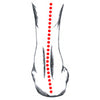
Low-arched feet (popularly known to the world as flat feet) excessively pronate (check above) when walking and running allowing your feet to propel, thus walking and running. However, overpronation minimizes shock absorption and subjects your feet to excessive ground reactive forces that can spell doom to not only your feet, but your legs as well- bunions, plantar fasciitis and shin splints just to name a few conditions. The solution? Find athletic shoes with ample arch support and rigid heel support to provide MOTION CONTROL.
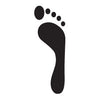

Neutral-arched feet (as seen above) are considered the most ideal among the three foot structures, in terms of the corrective measures to be considered when on that elusive shoe hunt. The magic word to keep in mind for neutral arches is: STABILITY. A good arch support, sound cushion, and stable heel support will always serve your feet well.
Whatever your foot type, there are still critical moments of truth that your athletic shoes need to prove that they are really the right pair for you (To be explained in an upcoming tip). STAY TUNED!
Don’t forget to LIKE US on facebook!!
Putting your best FEET forward,
SH
SOLE SEARCHING: 8 Tips to Finding Your Perfect Pair of Athletic Shoes (Tip #2)

Tip #2 Location, Location, Location
Looks like real estate isn’t the only topic where this phrase applies. Where we decide to buy our shoes can often make or break our chances of discovering that ideal pair. Choosing a major retailer or department store for shoe shopping can be a crapshoot when getting fitted for the right shoes. Often times, you have to take it upon yourself to find what you are looking for or the customer service that MIGHT be present has only limited knowledge to fit you properly.
You may be thinking: “Why don’t I just save myself the hassle and order my shoes online?” But, while eliminating the time spent looking for your shoes may put a smile ON your face, the possibility of receiving an ill-fitting pair of shoes may turn that smile into a frown. Finding a suitable pair is alot more involved than finding sneaks that are easy on the eyes and are described as having all the bells and whistles. If you are not aware of what to look and feel for shoes that fit you, then you can certainly do more harm than good.
To help with this dilemma, you might be better served seeking specialty retailers-for running shoes, etc. There, you will find sales clerks on staff that are trained to answer specific questions, analyze your gait, and recommend proper shoes for YOUR feet. Specialty stores may not be readily available in all areas, so you may have to do a bit of digging to find a location near you. A few extra steps to take, but your feet will no doubt thank you! (pun INTENDED).
Stay tuned! Next, we will go inside how your foot type can influence what features to look for when finding those goody two shoes!
Don’t forget to LIKE US on facebook!!
Putting your best FEET forward,
SH
SOLE SEARCHING: 8 Tips to Finding Your Perfect Pair of Athletic Shoes (Tip #1)

Photo courtesy of triathlete-europe.competitor.com
75% of Americans will experience foot problems at least once in their lifetime. In fact, the foot problems the many of us experience don’t stem from congenital conditions, but are the result of the rigorous wear-and-tear of our daily lives. Match that with the neglect and lack of proper foot care awareness and it’s quite easy to see how our feet can fall victim to those nagging aches.
One crucial step that can be taken for us to combat the war on achy feet is to wear proper fitting athletic shoes. However, there is a plan of action that we should have when on the hunt for that perfect pair.
Below is the first of what will be a series of tips to finding that perfect pair of athletic shoes…….as we like to call those goody two shoes.
Tip #1 Golden Time of Day
It’s best to shop for that perfect pair late in the afternoon. During the course of the day- when we are most active- the endless running, walking, and standing causes our feet to swell. By fitting for shoes when your feet are at their largest, ensures that your feet will be most comfortable in that pair when your feet are at their smallest- in the beginning and middle of the day.
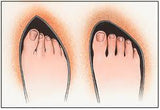
Photo courtesy of www.aboutorthowest.com
REMEMBER, the contour of your shoe should fit around the contour of your foot (above, right), NOT vice versa (above, left)! There should be no bulges felt- or seen- in a properly fitted shoe. Think of it as a hand-in-glove relationship…only for the foot.
Putting your best FEET forward,
SH




